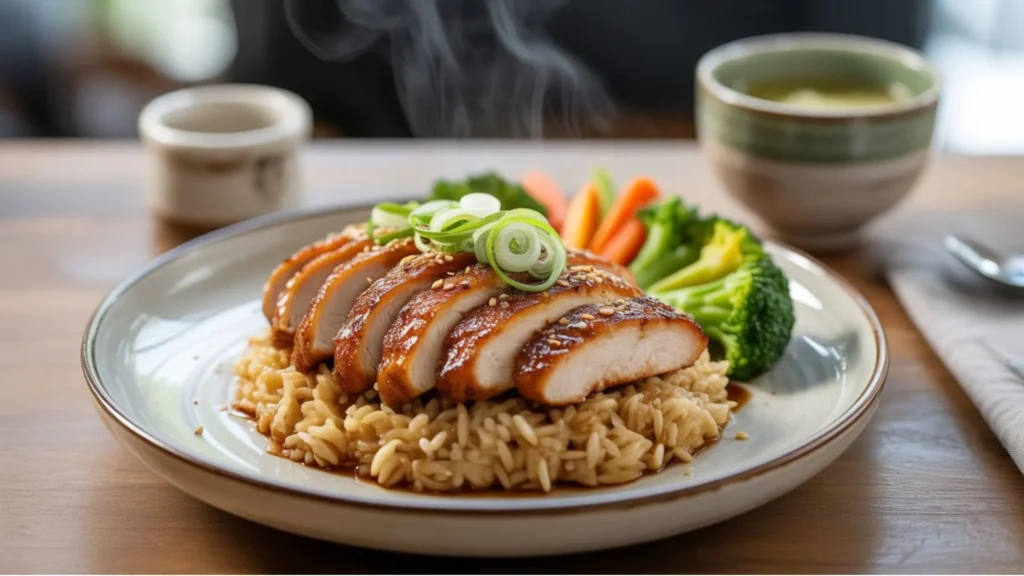Table of Contents
When life feels fast and food becomes just another task on your to-do list, cooking something that brings both comfort and health can feel like a small victory. That’s exactly what makes the Japanese Mounjaro Recipe so special. It’s more than a meal — it’s a quiet moment of balance in your busy day.
Imagine sitting down together after work, the aroma of toasted sesame and warm miso filling your kitchen, and knowing that what you’re eating is doing more than satisfying hunger. It’s fueling your body with clean, nourishing energy.
If you’ve been looking for a dish that’s easy to make, deeply flavorful, and surprisingly good for you, you’re about to fall in love with the Japanese Mounjaro Recipe — a hidden gem in Japanese home cooking that delivers both taste and health in one beautiful bowl.
For more inspiration from across Asia, explore our favorite Asian cuisine ideas and discover how different cultures balance flavor and wellness.
What Is the Japanese Mounjaro Recipe?
At its heart, the Japanese Mounjaro Recipe is a wholesome, balanced dish built around Japan’s timeless principles of washoku — harmony between ingredients, nutrition, and presentation. Traditionally, it’s a warm bowl that combines grains, vegetables, and lean protein, layered with light umami flavors that make every bite comforting.
Think of it as Japan’s answer to the “power bowl.” It’s simple, customizable, and designed to nourish your body without weighing you down.
In Japanese homes, dishes like this represent balance: a bit of grain, a handful of greens, some plant or animal protein, and a flavor base that’s light but satisfying. The Mounjaro style draws on that same structure — minimal oil, natural ingredients, and mindful preparation.
Why You’ll Love Making It
You don’t need to be a pro chef to master this recipe. You’ll find that it’s:
- Quick to prepare – most versions take under 30 minutes.
- Flexible – easy to adapt with whatever’s in your fridge.
- Budget-friendly – built around basic pantry items like rice, tofu, or miso.
- Nutritious – packed with fiber, plant-based protein, and essential nutrients.
Plus, it’s a great way to bring you and your partner together in the kitchen — chop, stir, and taste as you go. It’s cooking that feels grounding and joyful.
Japanese Mounjaro Recipe #1: The Classic Comfort Bowl
Description:
This version is what most people think of when they picture a warm Japanese-style bowl — fluffy rice, lightly sautéed vegetables, tender tofu, and a savory-sweet soy broth. It’s cozy, nourishing, and perfect for a weeknight dinner.
Ingredients:
- 1 cup uncooked brown rice
- 4 oz firm tofu, cubed
- 1 cup baby spinach
- ½ cup sliced carrots
- ½ cup shiitake mushrooms
- 1 tablespoon low-sodium soy sauce
- 1 teaspoon sesame oil
- 2 cups vegetable broth or dashi
- Optional: sesame seeds and chopped scallions for garnish
Instructions:
- Cook the rice according to package directions until tender.
- In a medium pan, heat sesame oil over medium heat. Add tofu and cook until lightly golden, about 3–4 minutes per side.
- Add carrots and mushrooms, sauté for 2–3 minutes.
- Pour in broth and soy sauce. Bring to a simmer and add spinach just before serving.
- Spoon the mixture over your rice, sprinkle sesame seeds, and enjoy hot.
Preparation Time: 10 minutes
Cooking Time: 20 minutes
Total Time: 30 minutes
Nutrition (per serving):
- Calories: 360
- Protein: 14g
- Fat: 8g
- Carbohydrates: 54g
- Fiber: 6g
Why It Works:
This version embodies balance — high in fiber and plant protein, low in fat, and rich in umami. The broth keeps it light while still filling you up.
Japanese Mounjaro Recipe #2: The Miso Fusion Bowl
Description:
If you’re craving something soothing and full of flavor, this miso-based version hits all the right notes. It’s gentle on your stomach, supports gut health, and tastes like a spa day in a bowl.
Ingredients:
- 1 tablespoon white miso paste
- 1 teaspoon grated ginger
- 1 cup soba noodles
- 1 cup chopped bok choy
- ½ cup cubed tofu
- 1 teaspoon rice vinegar
- 2 cups water
- ½ teaspoon sesame seeds (optional)
Instructions:
- Bring a small pot of water to a boil. Add soba noodles and cook for 4–5 minutes until soft, then drain.
- In another pot, combine 2 cups of water, miso paste, and ginger. Stir gently over low heat until the miso dissolves.
- Add bok choy and tofu, simmer for 5 minutes.
- Mix in noodles and rice vinegar; cook for 1 more minute.
- Serve warm, garnished with sesame seeds.
Preparation Time: 8 minutes
Cooking Time: 12 minutes
Total Time: 20 minutes
Nutrition (per serving):
- Calories: 290
- Protein: 12g
- Fat: 6g
- Carbohydrates: 46g
- Sodium: 380mg
Why It Works:
Miso is naturally fermented, giving this dish probiotics that support gut health. The ginger adds a digestion boost, while the noodles make it a cozy, satisfying meal.
Japanese Mounjaro Recipe #3: Protein Bento Bowl
Description:
When you’re looking for something that travels well and fuels you through the day, this bento-style version is perfect. It’s lean, clean, and bursting with texture — ideal for meal prep.
Ingredients:
- 1 cup cooked quinoa
- 4 oz grilled salmon (or chicken breast)
- ½ cup steamed edamame
- ½ cup cucumber slices
- 1 teaspoon low-sodium soy sauce
- ½ teaspoon mirin
- Lemon wedge for garnish
Instructions:
- Grill or pan-sear your protein until golden and cooked through.
- Layer quinoa as the base in a bowl or lunch box.
- Arrange salmon, edamame, and cucumber slices on top.
- Drizzle with soy sauce and mirin; squeeze lemon before serving.
Preparation Time: 15 minutes
Cooking Time: 15 minutes
Total Time: 30 minutes

Nutrition (per serving):
- Calories: 410
- Protein: 27g
- Fat: 10g
- Carbohydrates: 45g
- Omega-3s: 1,200mg
Why It Works:
This is your high-protein version of the Japanese Mounjaro Recipe — great for recovery after a workout or a busy day. It’s full of heart-healthy omega-3s and fiber-rich grains.
3 Surprising Health Benefits of the Japanese Mounjaro Recipe
1. It Naturally Supports Gut Health
The secret lies in ingredients like miso, tofu, and fermented soy products. These provide live cultures that feed good bacteria in your digestive system. A healthy gut means improved immunity, better mood regulation, and even clearer skin.
Quick Tip: If you use miso, add it to warm (not boiling) water — high heat can kill those beneficial probiotics.
2. It Helps You Manage Weight Without Deprivation
Unlike many Western comfort foods, the Japanese Mounjaro Recipe keeps calories in check without cutting flavor. You’ll enjoy generous portions of vegetables and lean proteins that keep you full longer.
A typical serving is around 350–400 calories, which makes it ideal for dinner if you’re watching your intake but still want something satisfying. The combination of fiber and protein helps stabilize blood sugar, so you don’t get that post-meal crash.
3. It Promotes Heart and Metabolic Health
Healthy fats like sesame oil, omega-3s from salmon, and antioxidants from fresh produce work together to support your heart and metabolism. These ingredients have been shown to reduce inflammation and help maintain healthy cholesterol levels.
Pair that with the low sodium and high nutrient density of traditional Japanese cuisine, and you’ve got a meal that feels indulgent but is doing your body a huge favor.
Tips for Perfecting Your Japanese Mounjaro Recipe
- Mind the broth. Use low-sodium soy sauce or tamari to keep salt levels down.
- Keep it colorful. Aim for at least three different vegetables — the more variety, the better your vitamin intake.
- Cook with balance. Japanese cooking is all about restraint. A light drizzle of sesame oil goes a long way.
- Prep ahead. Chop veggies and cook your grains in advance to make assembly easy on busy nights.
Smart Ingredient Swaps
- Substitute quinoa for rice if you want more protein.
- Use tempeh instead of tofu for a firmer, nuttier texture.
- Replace soy sauce with coconut aminos for a soy-free version.
- Add zucchini noodles if you’re following a low-carb plan.
These swaps keep the dish versatile while still staying true to its spirit — light, balanced, and deeply nourishing.
How to Serve and Store It
You can serve your Japanese Mounjaro Recipe as a warm main dish or a chilled bento-style lunch. For sides, consider:
- A small bowl of miso soup
- Pickled ginger or daikon radish
- A cup of green tea
Storage Tip:
Store leftovers in an airtight container for up to 3 days in the refrigerator. Reheat gently over low heat or enjoy cold — it’s delicious both ways.
Nutritional Snapshot (Average per Serving)
- Calories: 370
- Protein: 16–28g (depending on the version)
- Fat: 8–12g
- Carbohydrates: 45–50g
- Fiber: 5–7g
- Sodium: 400–600mg
Each version gives you a balanced ratio of macros — making it ideal for anyone looking to eat healthier without sacrificing satisfaction.

FAQs About Japanese Mounjaro Recipe
What makes Japanese Mounjaro Recipe healthy?
It’s a clean combination of whole grains, plant-based protein, and fermented ingredients — everything your body needs for balance and wellness.
Can I make it vegan?
Absolutely. Replace animal protein with tofu, tempeh, or seared mushrooms and use vegetable broth.
Is it good for weight loss?
Yes. The high fiber and protein content keep you full longer, helping control calorie intake naturally.
Can I meal-prep this recipe?
Definitely. You can cook the base ingredients in advance and assemble your bowl in minutes.
Cooking Notes for Success
- Use fresh, seasonal produce whenever possible — it boosts both flavor and nutrition.
- Don’t overcook vegetables; they should stay slightly crisp for texture and nutrients.
- For an authentic Japanese flavor, keep your seasoning simple — let the ingredients shine.
The Heart of the Dish
What makes the Japanese Mounjaro Recipe special isn’t just its nutritional value — it’s the ritual of preparing and sharing it. You’re not just cooking; you’re slowing down, reconnecting, and giving yourself the kind of care that modern life often forgets.
Every chop, every stir, every bite — it’s a reminder that healthy food doesn’t have to be complicated. It just needs to be intentional.
Conclusion: Bring Japanese Balance Into Your Kitchen
Want to see how others interpret this dish? Visit this detailed guide on the Japanese Mounjaro Recipe for more variations and flavor ideas.
You don’t need to travel to Tokyo to experience the warmth of Japanese home cooking. With the Japanese Mounjaro Recipe, you can bring those calming, nourishing flavors right to your dinner table.
Whether you’re cooking for two or just for yourself, this recipe invites you to slow down, savor the process, and enjoy the small details — the sound of rice simmering, the aroma of sesame in the air, the first comforting bite after a long day.
If you’re ready to add more balance and beauty to your meals, roll up your sleeves and try the Japanese Mounjaro Recipe tonight. Your body — and your taste buds — will thank you.
Call to Action:
Grab your ingredients, light up your kitchen, and cook your first Japanese Mounjaro bowl tonight. Share it with someone you love, and taste the perfect harmony of health and flavor in every bite.
Have You Given This Recipe A Try?
There are no reviews yet. Be the first one to write one.

